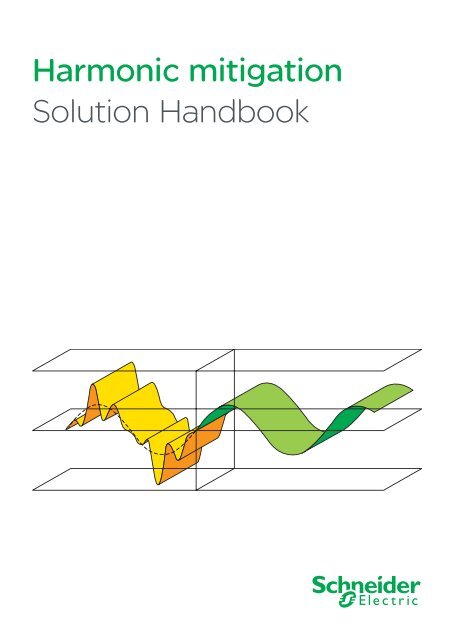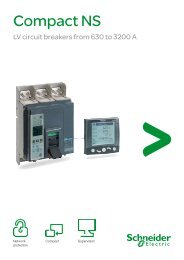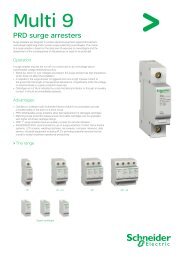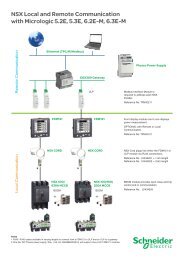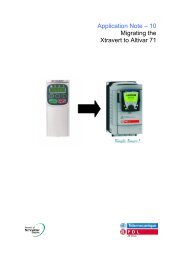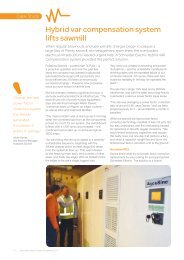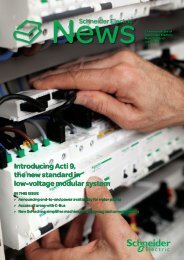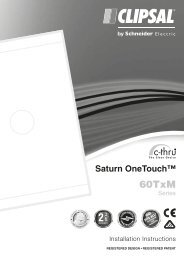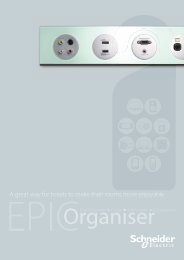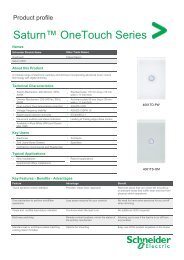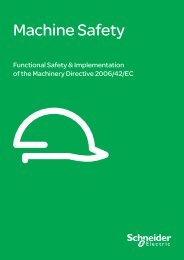view - Schneider Electric
view - Schneider Electric
view - Schneider Electric
- No tags were found...
You also want an ePaper? Increase the reach of your titles
YUMPU automatically turns print PDFs into web optimized ePapers that Google loves.
Benefits of Harmonic mitigation@ Up to 25% Capex and Opex reduction commonly achievable,@ Improved business performance: downtime significantly reduced, increasedequipment lifetime.Harmonic mitigation provides several benefitsthat could be translated into financial savingsfor the investor and for the user.We propose solutions which maximizethe savings when balanced with the costof the harmonic mitigation equipment to geta reasonable Return On Investment (ROI).In order to illustrate the benefits, we will takethe example of the following installation withtwo different situations.MV / LVAC drives standard typeLine current waveform (6 pulses):QDEitherCable length20mMaximum line r.m.s. current = 60AAltistart 48AC driveAC driveAltivar 21AC MotorTotal power = 292kW400VCos Phi = 0.86AC Motor22kW 400V10 times 22kW 400VAC Motor22kW 400VOrLine current waveformwith C-Less technology:In both cases, the transformer is chosen tokeep the Total Harmonic Voltage DistortionTHD u below 5%.Total harmonic distortion: THDi = 35%Line r.m.s. current = 38AUsage and simultaneity factors have been takeninto account for convenient sizing of equipment.5
Benefits of Harmonic mitigation (continued)Reduction of the capital expenditures (Capex)Saving on Capex is the permanent concern ofthe investor. Harmonic management gives theopportunity of significant savings. We will focuson the cost of equipment and will not quoteother savings such as space savings or labourcosts.Harmonic mitigation reduces the r.m.s. value ofthe current and so reduces the size of cables,the rating of circuit breakers and contactors, assummarized in the following table.In our example, the total Capex for the globalinstallation has been reduced by 15%.Without With Capexmitigation mitigation differenceDrive line current 60A 38ATransformer 800 kVA 630 kVA -11%Cables 16 mm 2 10 mm 2 -43%Circuit breakers NS80HMA80 NS80HMA50 -9%Contactors TeSys D50 TeSys D32 -40%Total -15%Reduction of the operating expenses (Opex)Opex will be impacted in different ways:@ Harmonic mitigation generally contributes toreduced power losses in transformers, cables,switchgear… The maximum savings shouldbe obtained considering the same equipmentratings. In the example given here, the energysavings are less significant compared tothe annual power consumption, becausethe advantage of lower currents has beencounterbalanced by higher impedance of theselected smaller transformer and cables.@ Harmonic mitigation allows reducing thesubscribed power to the energy supplier.This saving depends on the energy supplier.In most of the cases, savings could be up to10% of the electricity bill.In the given example, the annual savings onOpex is 4500€.Improved business performanceHarmonics are responsible for increased linecurrents, resulting in additional power lossesand increased temperature in transformers,cables, motors, capacitors…The consequence may be the unwantedtripping of circuit breakers or protection relays,and a reduced lifetime of equipment.For example, an increase of 10°C of theoperating temperature of a motor will result ina lifetime reduction by 50%.The cost of maintenance and repair may besignificant, but still relatively low comparedto the financial losses linked to a processinterruption.Here are some examples of over cost related toundesirable events on the electricity supply insome high value added industries.IndustrySemiconductorwafer processingFinancial companyData centreTelecommunicationSteelworksGlass industryFinancial losses per event3,800,000 E6,000,000 E per hour750,000 E30,000 E per minute350,000 E250,000 EThe related downtime and financialconsequences may be drastically reduced byproactive actions including harmonic mitigation.6
Active Front End (AFE)An AFE is the best performing solutionconcerning harmonic mitigation, limiting theTHDi below 5%. All the applicable standardrequirements can be met. No detailed systemevaluation is necessary, making this solution theeasiest to implement.Line-filterIn addition to harmonic mitigation, powerregeneration and power factor correction areinherent.MainsATV61, ATV71 incl. AFEActive filters<strong>Schneider</strong> <strong>Electric</strong> can propose 3 differentranges of active filters: SineWave, AccuSine,and Accusine Engineered Solution, which covera large extent of customer needs (range namesmay differ from one country to another). Theirmain characteristics are summarized below.SineWave@ Three or four wire connection (3 phase or3 phase + Neutral),@ 400 V supply,@ Units from 20A to 120A, with possible paralleloperation up to 480A,@ Cancellation up to the 25th harmonic.AccuSine@ Three wire connection,@ From 230 V to 480 V supply(higher voltage level possible with transformer),@ Filtering at network level, units from 50Ato 300A, with possible parallel operation up to3000A,@ Cancellation up to the 50 th harmonicAccuSineEngineered Solution (ES)@ Three wire connection,@ From 230 V to 480 V supply (highervoltage level possible with transformer),@ Filtering at network level up to 3000A,@ Cancellation up to the 50 th harmonic,@ Possible correction of individualharmonics,@ Advanced Human Machine Interface(HMI).9
Product offer (continued)Offer positioning3W: 3 wire4W: 4 wireby paralleling of units690V3WAccuSineAccuSine ES480V3WAccuSine3WAccuSineAccuSine ES400V4WSineWave20A 50A 120A 300A 480A 600A 3000AHybrid filterA hybrid filter is a system including a passivefilter tuned on the 5 th harmonic and a SineWaveactive filter in a single unit.Main characteristics:@ supply voltage: 400V,@ Passive filter tuned to the 5 th harmonic order,@ Active filter rated current: 20 to 180A,@ Reactive energy compensation: up to 265 kvar,@ Total harmonic current: up to 440A.10
<strong>Schneider</strong> <strong>Electric</strong> solutionsAt installation levelAt the installation level, the type of adaptedfilter has to be defined first, and then theadapted product or solution has to be selectedaccording to the customer's needs.The selection of the filter technology is basedon 2 parameters:@ Requirement for reactive energycompensation (improvement of DisplacementPower Factor, cosϕ),@ Maximum harmonic order to be treated.cos ϕ1.000.900.85ActivePassiveHybridWhen the DPF is lower than 0.85 – 0.9, apassive or hybrid solution is preferred.The proposed selection is represented on theopposite diagram.57 11 25 50Harmonic orderAt equipment levelSelected applicationsThe different solutions proposed by<strong>Schneider</strong> <strong>Electric</strong> are presented on the oppositechart in terms of power and achievable currentdistortion (THD i ).5%Active filterTHD i2.2kW 15kW 75kW 400kW 800kW 2400kWActive Front End18 – 24 pulse10%Passive filter12 pulse40%C-less (ATV21)Basic productATV21ATV312ATV12ATV61-71ChokeOn the opposite chart is presentedan over<strong>view</strong> of harmonic mitigation solutionsbased on efficiency and price.Efficiency98%C-lessChoke12 p18-24 p97%The scale on the X-axis is representative ofthe total price of the drive plus the associatedmitigation equipment.Active and passive filters are plotted on theabove chart as solutions implemented atequipment level. Their competitiveness isimproved when they are implemented at networklevel.96%95%Passive Filter Active FilterAFE110% 150% 200% 250%11
Guidance for a solutionFor a new installation, the first step is toevaluate the global situation, select thecorresponding standard and determine ifmitigation is necessary or not. The activitysector, the network parameters and the powerof non-linear loads have to be considered.Here are the major recommendations:@ If harmonic mitigation is necessary,global mitigation should be considered first.This is because single large mitigationequipment at the installation level is usuallymore cost effective than several small ones atequipment level.@ When large drives are present, (≥ 400kW),local mitigation is recommended. Typicalsolutions include multi-pulse configurations,Active Front End (AFE), and active filter.@ When a large number of drives are present,the implementation of chokes is recommended(AC-line or DC-link chokes).@ When PFC capacitors are present, detunedbanks should be preferred, with active filter iffurther attenuation is needed. This will ensurecapacitor protection and avoid resonance.@ When PFC capacitors are not present, anactive filter is the preferred solution.The following diagram indicates in whichsituation the different solutions are the bestadapted.ΣP/S n41Active filter + chokesPassive filter + chokes23Multipulse0.40.20.10115 kWC-less or chokes400 kW P unitP unit : unit powerS n : agreed powerΣP : total drive powerThe two considered criteria are the unit powerof the installed drives (P unit ), and the ratio of thetotal power of drives (ΣP) related to the agreedpower of the installation (S n ).@ Area 1: C-less technology or chokes are thebest solution. Chokes can be embedded or notin the drives. C-Less drives do not require anychoke.@ Area 2: Drives represent a significant partof the total power. A filter is necessary, inconjunction with chokes. A passive filter iswell adapted when Power Factor Correction isnecessary (low value of cosϕ).@ Area 3: Drives represent a significant part ofthe total power. An active filter is well adaptedwhen no PFC is necessary. AFE is applicablefor large drives.@ Area 4: For drives of typically 400 kW andabove, a multi-pulse solution at equipmentlevel is more convenient in the majority ofcases because of better efficiency (up to 3%improvement compared to additional filter:active, passive, or active front end solution).In addition, a multi-pulse arrangement is usuallymore cost effective than other solutions.13
Solutions for a new installation (continued)Example: Managing Harmonics and resonancewith AccuSine Active Harmonic Filters (AHF) inan offshore ring main oil fieldAn international oil company planned theconstruction of a number of offshore oilplatforms to conserve generator fuel. This wasdesigned by installation of a 33 kV underseacabling system between the platforms.This resulted in large voltage resonancepotential, linked to the presence of AC and DCmotor drives at both MV and LV levels.The entire ring is 150 km in length. The totalcapacitive reactance was calculated to causeresonance at the generators between 250 and550 Hz for this 50 Hz system. Additionally, thefrequency will shift according to the load levelsand mix of loads operating. The predictedTHD u on a number of platforms at the 600 Vacdistribution bus was close to 15%.The first level of mitigation is the addition of lineinductance at the drives input. This providesextremely large gains in harmonic currentreduction. An additional benefit of addinginductance at the input of DC drives is thereduction of the voltage notch. The notch isgreatly reduced in depth resulting in lower to nosevere effects on other products.After considering a number of harmonicmitigation technologies, full spectrum AccuSineAHF were selected for the following reasons:@ Speed of operation (100μs real timeperformance),@ All non fundamental currents treated (not justcharacteristic harmonics),@ Significant further reduction in line notching,@ No addition of capacitors that enhanceresonance from the 33 kV ring main system.Four 300A AccuSine AHF were connected inparallel with the six 800HP DC drives of thedrilling package, with one additional 300AAccuSine AHF connected to the 900HP ACdrive.With the AHF switched on, the THD i at the600 V bus is reduced from 35% to 3.7%.Of particular significance are the reductions ofthe 5 th harmonic current amplitude from 232Ato 11A (95.4% removal) and the 7 th harmoniccurrent amplitude from 72A to 11A (84.3%removal) as well.The 11 kV THD u is limited to 4.1%.14
Example of AccuSine ES active filter implementationThe windy conditions in the Austrian Alpshave been the reason for building a new windfarm in the “Niedere Tauern” in Styria in 2002.By the way, this is the highest situated windpark in Europe. The average wind speedis 7m/s which is comparable to the windconditions on the North Sea. The wind millshave been installed on the top of a mountainin a very exposed position. This exposure toenvironment also requires a 21km branchline to the substation, which is realized byunderground cable.During commissioning, it was found thatthe generators in combination with the longcable create resonance on the system. Thisunforeseeable condition required compensationof certain harmonics.This was the right task for AccuSine ES, whichis able to be set up for correction of individualharmonics. Thereby AccuSine ES is connectedto the mains on the 33kV MV side of thesubstation via a transformer.Thanks to the adjustable compensation ofAccuSine ES, it was not necessary to redesignthe topology of the wind mills connection andto use the installation with full design power asplanned.Schematic diagramGSubstation33.3 kV110 kV30 kV ringActivefilterThe AccuSine ES active filteris installed inside a container:"Niedere Tauern" wind park project at a glance:@ Project name: Windpark Oberzeiring@ Customer name: Tauernwind@ Contractor: ELIN EBG@ Success factors:- Adjustability of individualharmonics,- Staff expertise,- Customer intimacy.Website: www.tauernwind.com15
Solutions for existing installationsExample of implementationof an active filter at a Waste Water Treatment PlantA wastewater treatment plant installedVariable Frequency Drives (VFDs) to improvecontrol of raw sewage pumps and to decreaseoperating costs through variable speedoperation. A variety of unexpected problemsoccurred, including interference with thecomputer management system. Dependingupon the speed of the VFD raw sewagepump system, the circuit breaker protectingthe management control system would trip,shutting the plant down.The downtime risk included the potential forpartially treated sewage to be dumped into anearby river.Consultants were hired to analyze the situation.It was determined that harmonic control wouldbe necessary to insure system integrity. First,an input line reactor was installed and it waspartially successful. However, the problempersisted when the system operated at nearfull load and speed conditions. Installation ofan AccuSine active filter eliminated the problemcompletely.This installation required an AccuSine ratedat 50 amperes and 480 volts performing activeharmonic control, canceling the harmoniccurrent demanded by a VFD rated at 125horsepower.AccuSine successfully reduced the totalharmonic current distortion (as defined by IEEE519) from 39.0% to 4.1%, insuring trouble freeoperation of the plant. See the chart recordingsbelow.Tek Run: 50.0 kS/s HI ResTek Run: 50.0 kS/s 15 acq[ T ] [ T ]Ch1 Zoom 1,0X Vert 0,2K HerzCh1 Zoom 1,0X Vert 0,2K Herz18
Solutions for existing installations@ Which solution should be adopted for connection of a non linear load(e.g.: Variable Speed Drive)?When a new piece of equipment is connectedto an existing installation, it has to be checkedif the connection is possible straightforward orif there are conditions to be taken into account.This is especially true for non-linear loads suchas Variable Speed Drives (VSD) or UninterruptedPower Supplies (UPS) for example.There are two possible cases for the connectionof a new VSD:@ The motor driven by the VSD did not existbefore and thus it is an extension of thenetwork. In this case, of course, it has to bechecked if the power is available from thesupply system and the leads are sized for theadditional current to be drawn,@ The motor driven by the VSD existed before,but was started using direct on line connectionor a soft starter. In this case the power of thesupply system and the leads will fit.After this basic check, the examination of theharmonics can be started.Guidance for a solutionThe evaluation and selection of a suitablemitigation solution for non-linear loads canfollow three successive steps:Select the relevantharmonic emission limit (equipmentor installation standard).The first step is to identify if there is a standardto be applied and if yes, which one. Standardscan either apply on equipment (limits applied onTHD i ), or on the global installation (limits appliedon TDD or THD u ). Note that applying globalinstallation harmonic limits at equipmentlevel is not cost effective.For evaluating the influence on the system,the definition of the applicable PCC is veryimportant. For most industrial installations, thePCC will be on the MV side of the supplyingtransformer.If harmonic mitigation is neededor advisable, consider equipmentmitigation first.This will usually give the most cost effectivesolution.@ Total drives power up to about 100kW:This power usually represents less than ~20%of the transformer rated power. The standardsolution is to use AC-Line or DC-link chokes.These optional chokes reduce the THD i valuein the range of 35 to 45%. The resulting THD uwill therefore typically be from 2 to 3% and wellaccepted in most installations.20@ Total drives power fromabout 100 kW up to about 1,000kWIn this power range, it is advisable to have thetransformer power equal to at least 2.5 timesthe drives load. The standard solution is to useAC-Line or DC-link chokes. Depending on thetransformer size and cable length, the resultingTHD u can be up to ~6%. This could givepossible nuisance, but is usually well acceptedin industrial networks.@ Total drives power higher than 1,000 kWIn this power range, drives are usually equippedwith a dedicated transformer directly suppliedfrom the MV network. A 3-winding transformeris commonly used, providing a 12-pulsesupply for the drives. This considerably limitsthe harmonic emission and usually no furthermitigation is necessary. In addition, multi pulsesolutions are the most efficient in terms ofpower losses. Compliance to IEEE 519 is alsoeasy to reach.Check impact onexisting equipment of installationWhen a new non-linear load is connected toan existing installation, it has to be checked ifit can have an influence on other componentsalready connected on the same network.This is especially the case for capacitors andactive filters.@ Capacitors are presentIf capacitors are already present in theinstallation (Power Factor Correction or passive
harmonic filter), there is a risk of overloadand resonance introduced by the additionalharmonic currents.Usually the supplier of the PFC or passive filteris able to evaluate the situation and should becontacted first.@ Passive or hybrid filter is presentThe installed filter can be kept unchanged if itis oversized and can match the new currentrequirements. Otherwise, the passive elementmust be redesigned, as it is not possible toconnect another element in parallel with exactlythe same frequency tuning.@ Active filter is presentIf an active filter is present, non-linear loadsmust always be equipped with line chokes. Thiswill significantly reduce the harmonic currentemission and thus the necessary current ratingof the active filter.No risk is introduced by the additional harmoniccurrents as the active filters are usuallyprotected against overload. However, thecancellation of harmonic currents may not betotally effective, and the global performancemay be deteriorated.Usually the network designer is able to evaluatethe situation and should be contacted first.Example of implementation of a 12-pulse arrangementThe "Centre National de la RechercheScientifique" CNRS in Grenoble, France, is thelargest governmental research organization inFrance and the largest fundamental scienceagency in Europe. All together 30,000 peopleare working for CNRS as researchers,engineers, workers and administrative staff.The cooling water demand of one of theresearch departments is covered by 3 pumpsof 470kW each, whereas two are for normaloperation and the third one is in standby forsafety reasons.For process improvement purposes, variablespeed operation of the pumps has beendecided and variable speed drives have beeninstalled. Since the drives are non-linear loadswhich produce harmonic currents, harmonicmitigation was important to consider. On oneside, the electricity supplier EDF requiredcertain limits of THD i to be kept. On the otherside, all the scientific equipment should notbe disturbed by low power quality. Thereforethe decision was made to adopt a 12-pulsearrangement.Schematic diagramATV61HC80YM3 ~470 kW, 500V2960 rpmIn = 650A500VIn = 721AATV61HC80YM3 ~470 kW, 500V2960 rpmIn = 650A15 kV1250 kVA500VIn = 721ABy choosing Altivar frequency converters, thebenefits for the customer are that the drivesare prepared for 12-pulse connection asstandard and no additional equipment has tobe ordered. Besides, <strong>Schneider</strong> <strong>Electric</strong> offeredan “Engineered Drives” solution ready to usewith all necessary components within propercubicles.The harmonic performance is within theexpectation and all systems work properly.ATV61HC80YM3 ~470 kW, 500V2960 rpmIn = 650A21
Solutions for existing installationsView of the 3 cubicles12-pulse solution at CNRS Grenoble at a glance:@ Project name: CNRS cooling water pumps@ Customer name: CNRS Grenoble@ Contractor: <strong>Schneider</strong> <strong>Electric</strong>, Project and Services@ Product: 3x ATV61HC80Y, 500V, 630kW@ Success factors:- 12-pulse connection as standard- Harmonic performance- Engineered Drives cubicle.Internet: www.grenoble.cnrs.frExample: implementationof C-less technology in HVAC applicationsAC Drives are now recognized by EndUser, Consultant engineers and mechanicalcontractors as a major contributor to energyefficiency in HVAC applications (pumps andfans).Altivar ATV21 is the drive dedicated toHVAC. Its C-Less technology coupled withan advanced algorithm results in the lowesttotal harmonic distortion of the current (THD i )compared to other technologies, while reducingCapex and OpexArea TZB is a system integrator in CzechRepublic that delivers complete equipmentfor buildings, from the design to theimplementation.Their requirements are:@ An optimized sizing of the electricalinstallation,@ Short commissioning time (proper operationsof the installation without disturbances),@ Short implementation time of the equipments.According to their experience, the requirementsfor the AC drives are:@ Low THD i ,@ Management of EMC inside the drive,@ Easy installation,@ Easy start-up.After a first test in a building with 12 piecesof Altivar ATV21 with IP54 enclosure, Area TZBrecognized that Altivar ATV21 fully meets theirrequirements.22
Solutions for existing installationsFirst example: Implementationof an active filter at offshore gas platformFirst step: PriorityThe action was initiated because a mechanicalresonance of pump motors was responsible ofproduction limitations. The set objective was toimprove the availability of the system.Second step:Assessment of the situationThird step: Selection of solutionAn AccuSine active filter has been selected,based on cost and ease of installation.Benefit: Increased production resulting in $6000additional income per day.ROI: 4-5 daysHarmonic distortion was found responsible forthe mechanical resonance.Results of measurement: THD i ~ 30%,THD u ~ 10-12%Second example: Implementationof a 12-pulse solution for a pump applicationFirst step: PriorityThe flow regulation of a pump should getadapted to the demand of the process bymeans of a frequency converter. The overallobjective is to improve energy efficiency andtherefore the losses (Opex) of the systemshould be optimised.Second step:Assessment of the situationHarmonic distortion is relevant at the PCC onthe MV side of the factory. Therefore, a THD iof 15% is sufficient for the installation of thispump. The customer wants to compare an AFEsolution with a multi-pulse solution.Third step: Selection of solutionA 12-pulse supply has been selected, basedon cost and energy efficiency reasons.The installation cost (Capex) for an additional12-pulse transformer*) is roughly the same asfor an AFE drive. But efficiency of a 12-pulsedrive (incl. transformer) is around 1.5 to 2%better than a AFE drive.For an 1,200 kW drive, this results in energysavings of up to €11,000 each year and a CO 2emission saving of 64,000 kg!*For new installations a transformer is usually neededanyway. In this case the installation cost (Capex) for a12-pulse solution is a fraction as for an AFE solution!24
@ Which solution to adopt for connection of Power Factor Correction capacitorsin an existing installation?Network characteristics, and in particularnetwork background distortion, must absolutelybe taken into account when choosing a PowerFactor Correction system.Devices using power electronics (VariableSpeed Drives, rectifiers, UPS, fluorescentlamps, etc.) generate harmonic currents inelectrical networks.Capacitors are highly sensitive to harmonicsand they can also amplify the present harmonicdistortion of an installation due to a resonancephenomenon. A high level of harmonicdistortion causes capacitors to overheat,leading to premature ageing and possiblebreakdown.For existing installations, it is recommendedharmonic measurements be performed.The selection of the appropriate PFC solution is made:@ According to the percentage of total harmonic current distortion THD i measuredat the transformer secondary, at maximum load and with no capacitor connected:THD i (%) Classic Comfort Harmony Filters≤ 5%5% < … ≤ 10%10% < … ≤ 20%> 20%@ According to the percentage of total harmonic voltage distortion THD u measuredat the transformer secondary, at maximum load and with no capacitor connected:THD u (%) Classic Comfort Harmony Filters≤ 3%3% < … ≤ 4%4% < … ≤ 7%> 7%When contractual emission limits areto be met at the installation level, a harmonicstudy is required. The possible filter may beof different technologies:@ Active,@ Passive,@ Hybrid.Varset capacitor banks25
Solutions for a machine@ How to design a machine that includes non linear circuits in order to complywith harmonic emission limits?Two types of machines are distinguished:@ Catalogued machine : a standard machinethat fits the needs of most of the customers,@ Special machine: a machine that is dedicatedto an End User with his own specifications.The compliance with the standards is:@ The responsibility of the OEM but <strong>Schneider</strong><strong>Electric</strong> is ready to provide solutions,@ Not required at the drive level but at themachine level. The main difference is that at themachine level, all the pieces of equipment mustbe taken into account (linear or non-linear) forthe assessment of THD i .For catalogued machines,2 questions should be asked to the customer:Does a machine standard exist?If Yes: compliance to the standard is required.A typical example is a lift for which thecompliance to the product family standardis required (EN12015: "Electromagneticcompatibility. Product family standard forlifts, escalators and passenger conveyors.Emission").The solution is to use ATV71 "Lift" or ATV31"Lift" associated with a choke.Most of the machine standards do not specifyharmonic emission limits.Where is the machine installed(when no machine standard exists)?@ In a building (HVAC applications)- In a single motor machine such as Air HandlingUnits (AHU), compliance to IEC 61000-3-12 isgenerally requested. Mitigation has to be doneat the drive level. <strong>Schneider</strong> <strong>Electric</strong> solution isto use ATV21 that will provide a THD i down to30% as a standard.- Chiller, roof top, cooling tower, are multi-motormachines. A quick simulation could be done byusing HarmCalc software to determine whetherharmonic mitigation is necessary according tothe THD i calculated.- Other machines where power is higherthan 1kW. <strong>Schneider</strong> <strong>Electric</strong> advocates usingATV312 or ATV12: no harmonic mitigation isrequired.@ Do not knowIt is not possible to find a relevant standard thatcould be applied. The harmonic mitigation, ifnecessary, is carried out at the installation level.For special machines, the specification isgiven by the End User or the system integrator.In order to understand the requirements andpropose solutions, it is necessary to get somedata on the installation.Special cases: when the machines or the drivescan be supplied by a generator. To ensure thenormal operation of the generator, the THD i atthe generator level should be limited: the limitsare given by the generator specifications.@ In a plant or in infrastructure:There is no requirement at the machine leveland, if necessary, the harmonic mitigation hasto be done at the installation level.For drives power above 15kW, <strong>Schneider</strong><strong>Electric</strong> advocates limiting the THD i at around50% in order to avoid cables and devices overrating. Altivar ATV 71 and ATV 61 integratea DC-link choke as a standard, which limitsthe line current at the same level as the motorcurrent. For high power machines (> 630kW),other solutions are recommended.26
To know moreDefinitionsOnly the most useful definitions and formulaerelative to harmonics are given hereafter.Some numerical values are also provided asillustration.Power Factor (λ) andDisplacement Power Factor (cos ϕ):The power factor λ is the ratio of the activepower P (kW) to the apparent power S (kVA) fora given circuit.Total demand distortion (TDD):Ratio of the r.m.s. value of the sum of allthe harmonic components, in percent of themaximum demand load current I L (15 or 30 mindemand).This variable is used within IEEE 519 to setharmonic emission limits.For the special case of sinusoidal voltage andcurrent with a phase angle ϕ, the Power Factoris equal to cos ϕ, called Displacement PowerFactor.Total Harmonic Distortion (THD):Ratio of the r.m.s. value of the sum of all theharmonic components of an alternating quantityup to a specified order (H), to the r.m.s. value ofthe fundamental component.Q represents either current or voltage.H is generally equal to 40. Higher values (up to50) are considered in some applications.The current THD is commonly noted THD i andis equal to:Public supply system:<strong>Electric</strong>al distribution system operated by acompany (Utility) responsible for supplyingelectricity to customers.Private network:<strong>Electric</strong>al system or installation belonging to aprivate company, supplied by the local Utility.Point of Common Coupling (PCC):Point in the public supply system, which iselectrically closest to the installation concerned,at which other installations are, or couldbe, connected. The PCC is a point locatedupstream of the considered installation. Mostof the time, the PCC is at the MV side of thepublic network.The PCC is the location where the THD ucompliance is required.From this definition, we can obtain this veryuseful formula:PCCPublic utilityMV networkThe voltage THD is commonly noted THD uand is equal to:Utility customerN° 2Utility customerN° 1PCCPublic utilityMV network28Utility customerN° 1Utility customerN° 2
Short-circuit Power (Ssc):Value of the three-phase short-circuit powercalculated from the nominal interphase voltageU nom and the line impedance Z of the systemat the PCC.Z is the system impedance at the powerfrequency. More detailed information on thecalculation of Z is given in IEC 61000-2-6:"Assessment of the emission levels in thepower supply of industrial plants as regardslow-frequency conducted disturbances".Generally, the short-circuit power S sc at thePCC can be obtained from the Utility.By considering the transformer impedance only,the short-circuit power can be derived from thetransformer impedance Z T given by the formula:Where:- Sn is the rated apparent power of thetransformer- u sc is the short-circuit voltage of thetransformer (%)Combining the two formulae, it comes:Short-circuit ratio (Rsce):Characteristic value of a piece of equipment(of rated apparent power S equ ) defined by theratio: R sce = S sc / S equFor example:- apparent power of a piece of equipment:S equ = 25 kVA- short-circuit power: S sc = 25 MVAThen, the short-circuit ratio is: R sce = 1000For determination of harmonic emission limits,IEEE 519 is considering the ratio I sc / I L , where:- I sc is the short-circuit current at the PCC,- I L is the maximum demand load current(fundamental frequency component) at the PCC.The short-circuit current I sc is linked to theshort-circuit power S sc by the formula:For a fully loaded installation, the maximumdemand load current I L is close to thetransformer rated current. Then:For example: Sn = 1500 kVAS sc = 25 MVAThen:For example: Sn = 1500kVAu sc = 6%Then, S sc = 25 MVA29
To know moreStandardsRegarding harmonics, the purpose ofstandardization is to ensure that the voltagedistortion at the PCC is kept sufficiently low, sothat other customers connected at the samepoint are not disturbed. This is the basics ofthe concept of "Electromagnetic Compatibility"(EMC).The current industry standards includedocuments relative to equipment anddocuments relative to distribution networkinstallations. All these documents are aimed atlimiting interference linked to harmonics.This means that the objective is to limit theimpact of connection of non-linear loadsin terms of voltage distortion and avoidunacceptable disturbances applied toneighbouring installations connected to thesame supply network. This is the basis of theconcept of "compatibility level".For easier applicability of these documents,limits for generated harmonic currents aregiven.Standards relativeto individual equipmentThe applicable generic international standardsare:@ IEC 61000-3-2: "Limits for harmonic currentemissions, equipment input current ≤ 16A perphase",@ IEC 61000-3-12: "Limits for harmoniccurrents produced by equipment connected topublic low-voltage systems with input current> 16A and ≤ 75A per phase".These documents apply to equipmentconnected directly to the Low-Voltage publicsupply network. They are not applicable toequipment connected in an installation suppliedat Medium Voltage by the local Utility.No standard is applicable to equipmentconnected in a private LV network (installationsupplied at MV level by the Utility).The harmonic current limits have been derivedby limiting the voltage distortion producedby a single piece of equipment to a fractionof the maximum acceptable global distortion("compatibility level").Variable speed drives are mostly impactedby IEC 61000-3-12 (applicable to equipmentwith line current >16A and ≤ 75A), as, perIEC 61000-3-2, no limits are applicable toprofessional equipment with a rated power>1kW and a line current 120 are:@ I 5 ≤ 40%@ THD i ≤ 48%It is possible to comply with these limits whenusing an AC-line or DC-link reactor.For variable speed drives, a specific standardhas been published: IEC 61800-3: "Adjustablespeed electrical power drive systems, EMCrequirements and specific test methods".This document refers to IEC 61000-3-2 andIEC 61000-3-12 for application at equipmentlevel on LV public networks.On industrial networks, or for equipmentoutside of the scope of IEC 61000-3-2 or61000-3-12, the suggested reasonableapproach is to assess the harmonic emissionfor the whole installation.The recommended approach in the differentsituations is illustrated on the following figure.30
Low VoltagePublicNetwork Industrial NetworkLight IndustryTHD i < 10% atinstallation levelCommercial & Light IndustryApplication of 61000-3-12at equipment levelLarge Industry SystemsApplication of IEEE 519, IEC 61000 3-6or similar30 kVA 100 kVA300 kVA Agreed PowerDocuments relative to installationsThe most relevant documents are listed below:@ IEEE 519: "Recommended Practices andRequirements for Harmonic Control in <strong>Electric</strong>alPower Systems" (1992),@ IEC 61000-3-6: "Assessment of emissionlimits for distorting loads in MV and HV powersystems" (2008),@ Engineering Recommendation G5/4-1:"Planning levels for harmonic voltage distortionand the connection of non-linear equipment totransmission systems and distribution networksin the United Kingdom" (2001),@ "Technical rules for the assessment ofnetwork disturbances", published by Austria,Czech Republic, Germany and Switzerlandauthorities (2004).@ "Arrêté du 17 mars 2003 Design andoperation technical requirements for connectionof electricity consuming installation to the publicsupply network", France (2003).Now under development is project IEC61000-3-14: "Assessment of emission limitsfor the connection of disturbing installations toLV power systems". This future document isthe first IEC document for harmonic limitationsapplicable to LV installations.All these documents have been elaboratedwith a strong involvement of the Utilities, asthey are aimed at the fulfilment of power qualityobjectives.Limits for installations can be also definedby a contractual arrangement or by nationalregulations (e.g.: in France, UK, ...).Here are examples of limits given in thesedocuments, and applicable for implementationof non linear loads such as variable speeddrives. For simplification, only limits relatedto the 5 th order harmonic and total harmonicdistortion are mentioned.IEEE 519The derivation of harmonic current limits isbased on the objective of voltage distortion atthe PCC. Particularly: V 5 ≤ 3% and THD u ≤ 5%.For installations supplied at LV or MV,considering the short-circuit current I SC and themaximum load demand current I L , the possiblerange for the 5 th harmonic current is between4 and 15%, for I SC /I L varying from 20 to 1000.In the same conditions, the possible range ofTDD is between 5 and 20%.ER G5/4-1Limits are given for aggregate loads,per customer. The maximum permissible 5 thharmonic current per phase I 5 is 28.9 A.If this limit cannot be met, the predicted systemvoltage characteristics at the Point of CommonCoupling (PCC) after connection should be:V 5 ≤ 4% and THD u ≤ 5%.31
To know moreGeneral statementStandards provide limits for voltage and/orcurrent harmonic levels. It is to be noted thatfor a given THD i level, the higher the R sce , thelower the THD u will be. (See following figure).On the contrary, considering the maximumauthorised THD u required by standards, thehigher the R sce , the higher the THD i can beallowed.THD uTHD i = csteTHD iTHD u = csteR sceR sce32
List of documents@ Cahier Technique 152: "Harmonic disturbances in networks, and their treatment"@ Cahier Technique 202: "The singularities of the third harmonic"@ Expert Guide n°4: "Harmonic detection & filtering"@ Expert Guide n°6: "Power Factor Correction and Harmonic Filtering Guide "@ <strong>Electric</strong>al Installation GuideRelevant websites@ www.reactivar.com@ https://www.solution-toolbox.schneider-electric.com/segment-solutions33
Notes34
<strong>Schneider</strong> <strong>Electric</strong> Industries SAS35, rue Joseph MonierF - 92506 Rueil-Malmaison Cedex (France)Tel: +33 (0)1 41 29 70 00http://www.schneider-electric.comAs standards, specifications and designs change from time to time,please ask for confirmation of the information given in this publication.Printed on ecological paper.Layout : <strong>Schneider</strong> <strong>Electric</strong> - J. GrisonPhotos : <strong>Schneider</strong> <strong>Electric</strong>Printing : imprimerie du Pont de Claix© 2008 - <strong>Schneider</strong> <strong>Electric</strong> - Tous droits réservés ART. 837335SLTED109014EN April 2009


